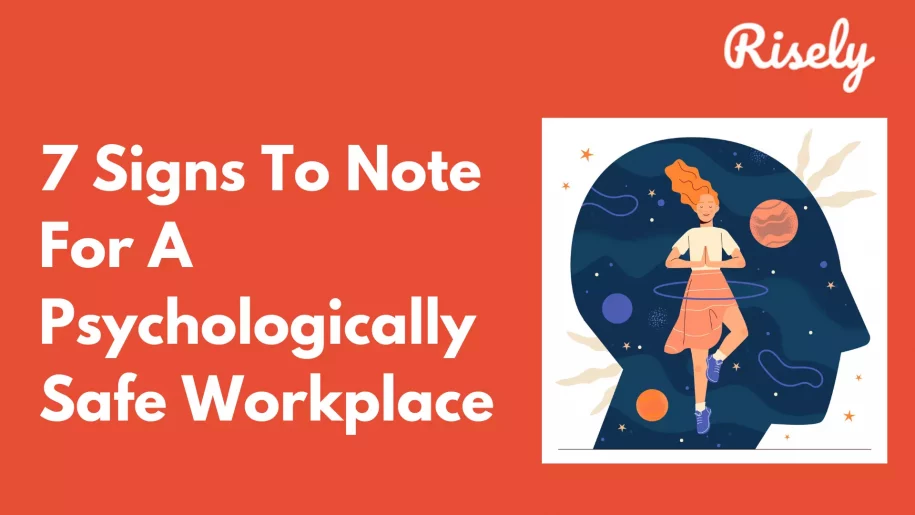7 Signs To Note For A Psychologically Safe Workplace
Workplace safety is a top priority for most people. While talking about workplace security, we need to look beyond physical safety. Mental and emotional safety is overlooked frequently. This becomes pertinent as we move towards toxic work cultures that promote working beyond the designated hours. Constantly overworking is a sign of working hard today. In this hustle-bustle, mental well-being’s value is lost somewhere. But what happens when the psychological safety of employees is not guaranteed? This blog highlights the importance of psychological safety and warns that your workplace may not be psychologically safe. It also provides tips on creating a psychologically safe working environment as a manager. By understanding the risks and taking appropriate measures, you can safeguard the mental health of your employees and ensure a healthy work-life balance.What is psychological safety?
Psychological safety is being accepted and feeling safe to be yourself around others. It is the freedom to be vulnerable around others without fear of others’ reactions. It’s a key ingredient to a healthy and productive workplace that catalyzes the growth of new ideas. If your workplace is psychologically safe, there is a culture of openness and honesty. Everyone feels supported and can express themselves freely. The emotional pain of employees is well-processed. Additionally, psychological resilience is high. And ultimately, the workplace environment feels safe and welcoming. If you see any signs of psychological safety being lax, it may be time to take action and improve the atmosphere. The best way to do that is to start with a culture of openness and honesty and encourage expression and debate. Leaders and managers need to [pay attention to the psychology of safety. Doing so will make psychological safety a reality for everyone in your office!The importance of psychological safety
Everyone wants a safe and healthy workplace, but achieving it is not always easy. A lack of psychological safety can harm the health and well-being of employees. Most importantly, when people feel unsafe, they cannot contribute to their full potential towards work. Moreover, research has shown that a lack of psychological safety can lead to decreased productivity, stress levels, and even feelings of anger and frustration. All of these are factors that raise concerns for managers. A study by Google concluded that psychological safety is among the fundamentals of a strong team achieving high productivity. The root allows the teams to gain other factors that enhance productivity. As a manager, you have to ensure the well-being of your employees; this includes health, whether it is mental or physical. Ensuring well-being is the initial step before demanding productivity from your employees. The absence of psychological safety can harm team dynamics and productivity. It can lead to a lack of trust, communication, and a fear of repercussions. Ultimately, it can be a cause of high turnover as well. A psychologically safe workplace also allows employees to be authentic, leading to creativity and innovation. A leader or a manager can create a significant impact on the environment. If you’re concerned that your workplace isn’t safe, here are seven signs that you need to take action:Warning signs that your workplace is not psychologically safe
Your workplace must be psychologically safe, meaning that your employees are not constantly feeling anxious or stressed. If you notice any of the following signs, it may be a sign that your workplace is not safe:People do not feel comfortable accepting mistakes
A common sign of the absence of psychological safety is that people are not comfortable accepting their errors. This can be due to fear of humiliation, criticism, and punishment they might receive due to the mistake. Effectively, accountability becomes low, and blame often gets shifted from one to another. A safe environment facilitates learning. This includes the scope for experimenting and failing as well. Employees no longer generate new ideas and innovation if fear curtails that scope. This forces the employees to remain limited to their defined job description instead of going beyond the call of duty and trying to do something new. Ultimately, it negatively impacts employee motivation and curtails their ability to achieve their full potential. More than a mere problem for the organization, it is also a hazard to the employee’s career development.Employees do not raise disagreements
The definition of psychological safety also includes the ability of people to raise their voices freely. The absence of psychological safety means a lack of a safe space to communicate. When employees do not feel safe but fear their ramifications, they will not be comfortable voicing dissent. In meetings, you will seldom see employees raising questions. Instead, the general response will be affirmative, towards the tune of acceptance. Effectively, the majority of the decisions will pass through without significant deliberations. This has a detrimental impact on performance. Moreover, the employees feel like mere cogs in the organizational machinery, as they cannot participate fully in the development stages.Feedback loops are non-functional
Similarly, in an environment that appears threatening to their psychological safety, employees will not go out of their way to seek feedback on their performance. You can see that the environment is harmful if the employees do not ask questions or seek guidance regarding their performance. Because instead of constructive feedback, they will expect diatribes and humiliation based on their previous experiences. Employees take feedback with a non-serious attitude due to the perception of the environment. Communication between managers and employees is effectively broken. This ends the chain of consecutive improvements that regular feedback can create. Both the employees and the organization stagnate in such a scenario.Other Interesting Reads
A few people dominate meetings
A typical sign of a psychologically unsafe environment is a few people’s dominations in the plan. These people rule the informal scene in conversations. Therefore, they can set the agenda accordingly. Similarly, in meetings, a few people take the lead and handle the whole issue instead of a broad involvement of everyone. The lack of contribution from employees is a clear sign of the presence of fear in them. Employees avoid participating as they see these interactions as leading to humiliation and criticism only. Eventually, in such situations, the managers have to take charge of the meetings and conclude most of the discussion among themselves.No personal connections
Apart from the domination of a few people, employees also get isolated from their colleagues. Lack of interpersonal connections leaves the employees with a feeling of loneliness and isolation. This happens easily if communication is limited to professional parlance only and space is not provided to connect with colleagues. This is usually done to control them. People who feel insecure tend to withdraw socially to protect themselves and those close to them. In such an environment, it becomes challenging for the employees to get support for their ideas or proposals. Moreover, increased isolation reduces the ability of employees to communicate effectively with one another, either in person or online, further deteriorating the performance of an organization.Information is not accessible
Psychologically unsafe environments usually do not have adequate outlets for dispersing information. Generally, the lower levels of the hierarchy have access to limited to no information. This might happen due to mistrust, a perception of inability to understand, or a lack of apparent need for sharing. The consequences of this behavior are detrimental to the organization’s health as it further increases the growing miscommunication. The absence of clear communication regarding the company’s upcoming plans and general happenings can leave the employees feeling directionless and alienation from their work. Additionally, the lack of well-constructed communication leaves space for grapevines to cultivate. These further denigrate the relations.Low employee morale
Workplace morale needs to remain high for progress to be made. A psychologically unsafe environment invariably hurts employee morale. The employees feel insecure and unsupported, which makes it difficult for them to give their best performance. Furthermore, when the employees cannot identify or express their grievances freely, they often lose confidence in themselves and start feeling demoralized. This can lead to reduced productivity and loss of faith in the organization. Additionally, a psychologically unsafe environment can give rise to many issues for the employees, such as distress, burnout, and physical health issues. Eventually, a psychologically unsafe environment speeds up turnover. Therefore, managers must create a safe environment where their employees can grow.
How to create a psychologically safe working environment?
Work is a necessary part of life but can also be stressful and demanding. It is vital to create a psychologically safe and healthy working environment for your employees to focus on their work and not their anxiety or stress. Creating a psychologically safe working environment means creating an environment where employees can be their true selves. This includes being able to express emotions, have to trust in one another, and feel comfortable enough to use their creativity and innovation without feeling afraid of repercussions. The first step is to understand the risks. You must know what factors jeopardize psychological safety and take appropriate measures accordingly. This includes creating an environment free from harassment, ensuring that all employees have access to support services when they experience emotional pain, and providing training on how to manage emotions in the workplace. Additionally, managers must maintain a constructive attitude towards their staff. It means being open-minded and supportive while maintaining boundaries so that employees feel comfortable sharing negative experiences with them. To further understand psychological safety and how to create it in your team, continue reading here.Conclusion
It’s no secret that a psychologically safe workplace is essential for the health and well-being of employees. In today’s competitive environment, standing out from the crowd is hard if your workplace isn’t psychologically safe. Creating an environment where team members feel supported and appreciated is important. Doing all of this takes a lot of effort, but it’s worth it if you want your employees to stay productive and happy. An organization that wants to be agile doesn’t work without psychological safety. Fortunately, there are a few easy steps to create a safe and healthy environment for your employees. By monitoring the signs listed in this blog, you can ensure that your workplace is a safe and conducive place to work. So, what are you waiting for? Start creating a psychologically safe workplace today!Build a psychologically safe environment by keeping constructive feedback effective.
Test the effectiveness of your constructive feedback skills with the free self-assessment now and learn where you need to work.
FAQs
Who are responsible for creating a psychologically safety at workplace?
Creating psychological safety in the workplace is a shared responsibility between leaders, managers, and individual employees. Leaders and managers must develop a culture of openness, trust, and respect. At the same time, employees must actively participate in creating a safe and inclusive workplace by communicating openly, respecting diversity, and supporting one another. Psychological safety is a collaborative effort that requires everyone’s involvement.
What are the interpersonal skills required to make a psychologically safe work environment?
Interpersonal skills required to make a psychologically safe work environment include active listening, empathy, respect for diversity, effective communication, conflict resolution, and teamwork. These skills enable individuals to understand and appreciate differences, communicate effectively, and work collaboratively to achieve shared goals. Interpersonal skills also help to build trust, foster positive relationships, and create a safe and inclusive work environment.
What are the benefits of psychological safety?
Psychological safety is an environment where individuals feel safe expressing their ideas, opinions, and concerns without fear of negative consequences. Benefits include improved team performance, increased creativity and innovation, better decision-making, higher job satisfaction and engagement, reduced stress and burnout, and more positive work relationships.
What is a psychology safety framework?
A psychological safety framework is a set of guidelines, principles, and practices to create a work or social environment where individuals feel safe expressing themselves without fear of negative consequences. It involves establishing trust, respect, and open communication, promoting inclusivity and diversity, and encouraging constructive feedback and learning. Such a framework fosters creativity, innovation, and collaboration while reducing stress, burnout, and turnover.
Other Related Blogs
Mental Health Month has come and gone. What’s beyond that?
Mental Health Month has come and gone. What’s beyond that? Mental Health Month has come and gone again. Come May, the social pages of every company you know are decked…
10 Tips to Fight Absenteeism at Work
10 Tips to Fight Absenteeism at Work The absenteeism of team members is not just a nuisance for managers but also costly for the team. By understanding absenteeism and its…
10 Ways Managers Create Psychological Safety For Their Teams
10 Ways Managers Create Psychological Safety For Their Teams Psychology safety is one of the most essential aspects of effective team management. Managers need to create a safe and psychologically…


